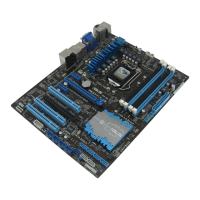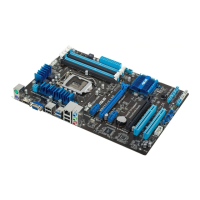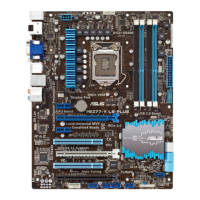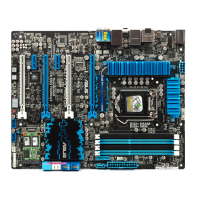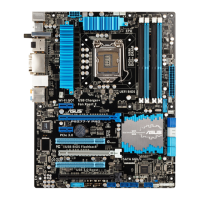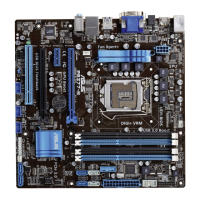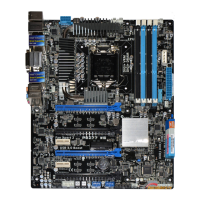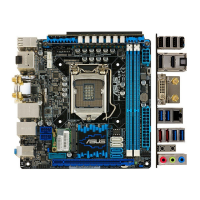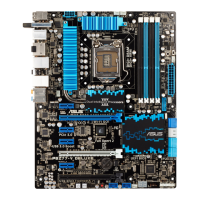
Do you have a question about the Asus P8Z77-V DELUXE and is the answer not in the manual?
| Non-ECC | Yes |
|---|---|
| Memory channels | Dual-channel |
| Memory slots type | DIMM |
| Number of memory slots | 4 |
| Supported memory types | DDR3-SDRAM |
| Maximum internal memory | 32 GB |
| Processor socket | LGA 1155 (Socket H2) |
| Processor manufacturer | Intel |
| Compatible processor series | Intel Celeron, Intel Pentium |
| Number of EATX power connectors | 1 |
| Number of Parallel ATA connectors | 0 |
| USB 3.2 Gen 1 (3.1 Gen 1) connectors | 2 |
| Headphone outputs | 5 |
| USB 2.0 ports quantity | USB 2.0 ports have a data transmission speed of 480 Mbps, and are backwards compatible with USB 1.1 ports. You can connect all kinds of peripheral devices to them. |
| USB 3.2 Gen 1 (3.1 Gen 1) Type-A ports quantity | 6 |
| Audio chip | Realtek ALC898 |
| Component for | PC |
| Motherboard chipset | Intel Z77 |
| Audio output channels | 7.1 channels |
| Motherboard form factor | ATX |
| RAID levels | 0, 1, 5, 10 |
| Supported storage drive interfaces | SATA II, SATA III |
| Graphics card | HD Graphics |
| Maximum resolution | 2560 x 1600 pixels |
| Parallel processing technology support | Quad-GPU CrossFireX, Quad-GPU SLI |
| PCI Express x16 slots | 3 |
| Wi-Fi standards | 802.11a, 802.11b, 802.11g |
| Ethernet interface type | Gigabit Ethernet |
| BIOS type | UEFI |
| BIOS memory size | 64 Mbit |
| Depth | 244 mm |
|---|---|
| Width | 305 mm |
Introduction to the P8Z77-V DELUXE motherboard and its quality.
Lists all items included in the motherboard package.
Highlights key technologies and unique features of the motherboard.
Important precautions before installing motherboard components or changing settings.
Detailed layout and identification of motherboard components and connectors.
Diagram showing the location of connectors, jumpers, and slots on the motherboard.
Guidance on the tools and components needed to assemble a PC system.
Lists essential tools and components required for PC assembly.
Step-by-step instructions for installing the CPU onto the motherboard socket.
Instructions for properly installing memory modules (DIMMs) into the slots.
Overview of the ASUS UEFI BIOS interface and its purpose.
How to enter and navigate the BIOS setup utility.
Explains the user-friendly EZ Mode for basic BIOS configuration.
Details the Advanced Mode for comprehensive BIOS settings and configuration.
Overview of system information and basic settings in the Main BIOS menu.
Configuration options for overclocking-related settings.
Options for configuring CPU, PCH, SATA, system agent, and onboard devices.
Settings related to CPU features, power management, and virtualization.
Configuration options for SATA modes (IDE, AHCI, RAID) and hot plug.
Displays system temperatures, voltages, and fan speeds; allows fan control.
Settings for system boot options, boot device priority, and NumLock state.
Access to utilities for BIOS updates, O.C. profiles, and SPD information.
Utility to update BIOS using a USB flash drive.
Options to load defaults, save, or discard changes and exit BIOS.
Procedures for updating the motherboard BIOS.
Guidelines for installing compatible operating systems.
Information about the contents of the support DVD.
How to launch and use the support DVD interface.
Overview of applications and utilities provided on the support DVD.
Integrated utility suite for system monitoring and tuning.
Software for CPU overclocking and system level up.
Supported SATA RAID solutions and configuration steps.
How to enable RAID function in BIOS setup.
Steps to create a RAID driver disk for OS installation.
Guide to installing and enabling ATI CrossFireX for multi-GPU setups.
Necessary hardware and software for ATI CrossFireX setup.
Step-by-step instructions for installing two graphics cards.
Guide to installing and enabling NVIDIA SLI for multi-GPU setups.
Necessary hardware and software for NVIDIA SLI setup.
Step-by-step instructions for installing two SLI-ready graphics cards.
Software for enhancing graphics performance and virtualizing GPUs.
Instructions for installing the LucidLogix Virtu MVP software.
How to configure display modes (i-Mode, d-Mode) for Virtu MVP.
Adjusting performance settings and selecting applications for Virtu MVP.
Regulatory statements and compliance information.
FCC compliance information for the device.
Canadian compliance and interference regulations.
Notices related to radio frequency equipment and wireless usage.



